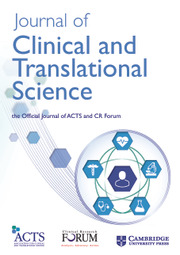No CrossRef data available.
Article contents
192 Developing a community laundromat intervention to increase reproductive health literacy outreach
Published online by Cambridge University Press: 03 April 2024
Abstract
OBJECTIVES/GOALS: The project goal was to conduct formative work using community-based participatory research (CBPR) to inform the development of a laundromat-based reproductive health literacy intervention (LI)informed by Passhe-Orlow and Wolf’s Conceptual Model. We provide insights to support the development of similar health literacy interventions. METHODS/STUDY POPULATION: In Phase I, we recruited female patrons over the age of 18 living in DC from 4 community laundromats. Participants completed a survey with validated measures to assess reproductive health knowledge, self-efficacy, and intentions to seek care. Open-ended questions assessed participants’ experiences accessing care, communication with health providers, and laundromat use. Data informed the development of a 2-3 minute reproductive health literacy intervention (LI) storyboard. In Phase II, in-depth interviews were conducted with reproductive health providers (midwives, obstetricians-gynecologists, women’s health registered nurses, women’s health nurse practitioners) working in the communities where the laundromats are located. LI acceptability and appropriateness were explored. RESULTS/ANTICIPATED RESULTS: For Phase I, we recruited 60 patrons. Participants (68.3%) expressed interest in a laundromat-based reproductive health literacy intervention (LI). Identified reproductive knowledge gaps included: unaware of fertile days (50.0%); believe prenatal care should begin after 2nd trimester of pregnancy (50.0%); unclear about pregnancy spacing (85.0%); unable to identify use for folic acid (91.7%); believe once a cesarean always a cesarean (53.3%). In Phase II, all 14 providers supported increasing community accessibility to health information: “we have to move beyond doing public health education in a provider’s office. That’s very outdated.” Providers identified the LI as an approachable, informative, and accessible way to disseminate health information. DISCUSSION/SIGNIFICANCE: Patron and provider input informed our choice of content, style, and delivery of the reproductive health literacy intervention. An essential aspect of our CBPR approach, this research will inform effective, appropriate reproductive health education despite barriers presented by access, transportation, and work schedules.
- Type
- Health Equity and Community Engagement
- Information
- Creative Commons
- This is an Open Access article, distributed under the terms of the Creative Commons Attribution-NonCommercial-NoDerivatives licence (https://creativecommons.org/licenses/by-nc-nd/4.0/), which permits non-commercial re-use, distribution, and reproduction in any medium, provided the original work is unaltered and is properly cited. The written permission of Cambridge University Press must be obtained for commercial re-use or in order to create a derivative work.
- Copyright
- © The Author(s), 2024. The Association for Clinical and Translational Science


